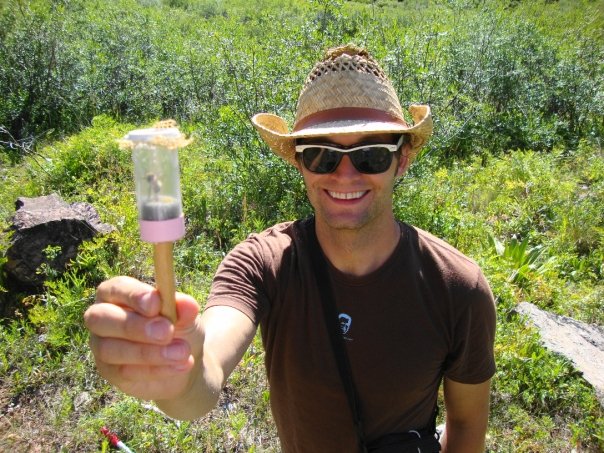HOW WILL CLIMATE CHANGE AFFECT PLANTS, POLLINATORS, AND THEIR INTERACTIONS?
As the climate changes, spring is arriving earlier and earlier across the globe. The migration of birds, mating of amphibians, and emergence of insects and flowers is happening earlier than it historically has due to the warming climate and early arrival of spring. The timing of these natural history events (known as “phenology”) can have dramatic consequences for species reproduction and survival. For example, when flowering plants bloom too early, the probability of experiencing frost damage and drought increases. Furthermore, approximately 90% of flowering plants require pollination by bees or other organisms for reproduction, but the phenology of bees might not respond to climate change at the same rate as flowering phenology. Therefore, plants and bees could emerge at different times, and experience a “phenological mismatch,” which is predicted to have negative consequences for both plants and bees. Although we know that plant reproduction tends to decrease when plants bloom too early, we do not know why, specifically. The focus of my research is to untangle the mechanisms behind changes in plant and pollinator reproduction as phenology varies, which will help to understand how plants and pollinators will respond to climate change. I employ field observations and manipulations in the Rocky Mountain West to investigate my research questions, as well as over 11 years of citizen science generated data on butterfly abundance from Central Florida.
1) HOW DOES ALTERING PHENOLOGY AFFECT PLANT REPRODUCTION AND WHAT ARE THE MECHANISMS INVOLVED?
Previous experiments have shown that altering plant flowering phenology can have consequences for plant reproduction, but the mechanisms driving the changes have not been well evaluated. I am using experimental approaches to alter flowering phenology of wildflowers to determine the effects of altered phenology on reproduction, pollen limitation, and plant-pollinator interactions, with the express goal of elucidating the mechanisms behind changes in plant reproduction with altered phenology. I am simulating a potential plant-pollinator phenological mismatch by altering flowering phenology, but not pollinator phenology, at a local level, thus allowing me to test the degree to which the strength of plant-pollinator mutualisms may be labile to variation in flowering time. I am experimentally altering flowering phenology of Claytonia lanceolata (Portulacaceae) and Delphinium nuttallianum (Ranunculaceae) using two methods: by altering snowpack (snow-removal vs. control treatments), and by inducing flowering in a greenhouse before placing plants in experimental outdoor arrays (early, control, and late phenology treatments).
2) HOW DO POLLINATOR (GROUND NESTING BEE) EMERGENCE AND PHENOLOGY RESPOND TO ENVIRONMENTAL CHANGES KNOWN TO AFFECT PLANT FITNESS AND PHENOLOGY?
Native bees are extremely important pollinators, contributing an estimated $3 billion worth of crop production annually to the U.S. economy as well as providing vital pollination services to many native plants. Over 70% of native bees nest in the ground. While it is known that flowering plant phenology is highly correlated with snowmelt date, the biotic and abiotic factors that affect ground-nesting bee emergence remain a mystery. Plant phenology in high-elevation areas has been shown to respond to snowmelt timing, and many of these plants rely on pollination services provided by ground-nesting bees; therefore, assessing the degree to which bee phenology also responds to snowmelt timing will provide information about the potential for plant-pollinator asynchronies. Using snowpack manipulations and emergence traps I am investigating how altering the timing of snowmelt affects the emergence and phenology of ground nesting sweat bees (Halictidae).
3) HOW DO PLANT AND POLLINATOR PHENOLOGY CHANGE RELATIVE TO ONE ANOTHER OVER A GRADIENT OF ENVIRONMENTAL CHANGE?
Long term pollinator phenology data that could indicate changes in peak abundances of plants and their pollinators over time is, unfortunately, scarce in North America. Substituting space (elevation) for time provides a proxy for many climate variables and can be used to investigate the occurrence of phenological asynchronies between co-occurring species. Climate change is predicted to cause warmer, drier climates in many systems. Low elevation areas tend to be warmer and drier than high elevation areas, therefore traveling up or down in elevation offers insight into the environmental changes expected over time given climate change predictions. Substituting elevation for time is among the most powerful “natural experiments” and is underutilized by ecologists studying climate change. In generalist pollination systems, I hypothesize that mid-season emerging plants and pollinators should suffer lower fitness losses as a result of altered phenology than early or late emerging species because of their ability to “change partners”; a luxury that the early and late emerging species may not be afforded. I therefore predict that synchrony between early and late emerging species will be maintained more than in mid-season emerging species.

